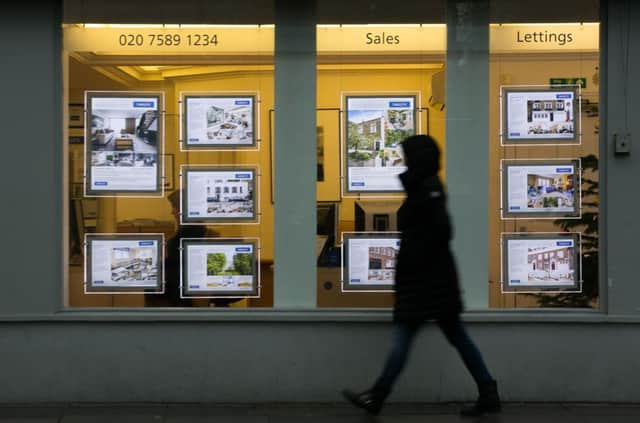Mind the gap


According to property analysts Hometrack, the gap between house prices in London and those in other major cities is at its widest in 20 years.
Meanwhile, separate research from Nationwide Building Society has found the gap between property values in Southern England and those in the North of England and Midlands has reached a record high of more than £150,000.
Advertisement
Hide AdAdvertisement
Hide AdThe widening North/South gap means a homeowner in Southern England, where the average property value is £303,811, could buy two properties in Northern England, where a typical house costs £150,851.
While house prices in London have surged by 10.6% over the last year according to Nationwide’s figures, those in Wales have edged up by only 1.9%, while prices in Northern Ireland have seen a 6.5% year-on-year increase.
Meanwhile, house prices across Scotland have fallen by 1.3%.
So with property markets behaving very differently, what would the price of a home in London get you in other parts of the country?
Advertisement
Hide AdAdvertisement
Hide AdWell, according to Hometrack’s figures, the average property price in London now stands at £437,700 on average.
That’s more than 12 times average national earnings and means someone could now buy around four typical homes in Glasgow, or three in Manchester, or two in Bristol, for the price of one in London.
In Birmingham, where the average property value is £134,800, a buyer could expect to get a 69% discount compared with the cost of a typical London property, while in Liverpool, where a home costs around £109,600, it would be 75%. In Leeds, the average home costs £144,200, giving a buyer a 67% discount and in Newcastle, where the average is £121,900, the discount would be 72%.
But what could these widening gaps mean for the future of the housing market?
Advertisement
Hide AdAdvertisement
Hide AdHometrack reckons some buyers may reach a tipping point, where they ditch the idea of living in or near to London completely, and instead set their sights on another city outside the capital offering better value.
Richard Donnell, director of research at Hometrack, says similar cycles in the property market have happened before, often lasting five to six years.
He predicts: “The gap will start to close in the next 12 months and definitely in the next two to three years.”
As property price increases in London become gentler, other parts of the UK could see growth pick up, he says.
Advertisement
Hide AdAdvertisement
Hide AdAn increase in prices outside London is particularly likely if the economy continues to grow and mortgage rates remain low, as this will help households to be confident about taking on mortgage debt, Donnell says.
But buying a property outside London is “not a guarantee” that its value will suddenly start to shoot up in the coming years, he says.
With property markets across the UK being very closely linked to local factors such as employment, some cities and regions may not see much house price growth at all.
HOW ARE... SAVERS USING NEW PENSION FREEDOMS?
More than six months have gone by since new freedoms were brought into force, allowing people aged 55 and over more freedom over how they use their pension cash.
Advertisement
Hide AdAdvertisement
Hide AdRather than being required to buy a pension income called an annuity, the over-55s have more flexibility to access their money as and when they want to.
So what have people been doing so far? Well, two firms, Standard Life and Fidelity Worldwide Investment, say that taking cash out for home improvements has been a popular choice, as has taking money out in order to pay off debts or a mortgage.
The findings point towards consumers behaving cautiously with their money - despite previously-raised fears that some people may blow the lot. Many people are simply leaving their money invested.
Richard Parkin, head of retirement at Fidelity Worldwide Investment, says: “What we’ve absolutely not seen is a mad rush to empty pots.”
‘40% OF CONSUMERS LENDING OR BORROWING THIS CHRISTMAS’
Advertisement
Hide AdAdvertisement
Hide AdAs Christmas draws nearer, two fifths (40%) of consumers are either planning to lend or borrow money to get through the festive season, according to research for rewards website, GetPaidTo.com.
The website, which is running a Christmas Saver Club, found that 24% of people are turning to family, friends or colleagues for financial support, while 16% have lent money to help someone enjoy Christmas.
Some 17% of the 2,000 people surveyed had taken on additional work to help fund Christmas.
INSURANCE DEALS FOR YOUNGER DRIVERS ‘GETTING MORE COMPETITIVE’
Advertisement
Hide AdAdvertisement
Hide AdYounger drivers could see the cost of their insurance fall in the coming months, helped by growing numbers of “black box” telematics policies, according to Comparethemarket.com.
More than three-quarters (77%) of under-25s are seeing at least one telematics premium crop up in their cheapest five quotes - up from 62% in 2014.
Telematics, or “black box”, insurance policies work by tracking a vehicle’s movements, helping insurers to reward good drivers with cheaper premiums.
Simon McCulloch, director of insurance at Comparethemarket.com, says: “If price competition continues to be high for young drivers’ policies, we may in fact see premiums start to decline for under-25s, whilst they rise for everyone else.”
NEW GOLD BAR LAUNCHED COSTING £25,000
Advertisement
Hide AdAdvertisement
Hide AdThe Royal Mint is offering “serious investors” with around £25,000 to spare, the chance to buy a fine gold bar weighing one hefty kilogram.
The new gold bars, worth £24,000-£25,000, depending on changing gold prices, have been produced to mark the first anniversary of a bullion trading website launched by the Mint.
The www.royalmintbullion.com website has attracted more than 12,000 customers from across the world since it launched in September 2014.